Author: Chainalysis Team; Translation: Wu Shuo Real
Central Asia, South Asia, and Oceania (CSAO) have the most vibrant and attractive cryptocurrency markets in the world. In terms of raw trading volume, Central Asia and Oceania are the third largest cryptocurrency market we studied, behind only North America and Central, Northern, and Western Europe (CNWE), accounting for less than 20% of global trading volume.
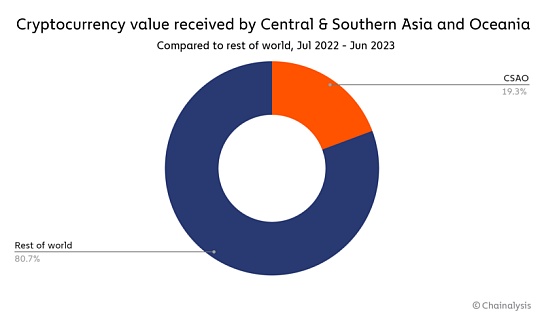
- OP Research AA | Signs of On-chain Ecology Entering the Buyer’s Market
- 4 Data Reveals Cryptocurrency Market Development far More Optimistic than Imagined
- The US government is about to face another ‘shutdown crisis’. What impact will this have on the cryptocurrency market?
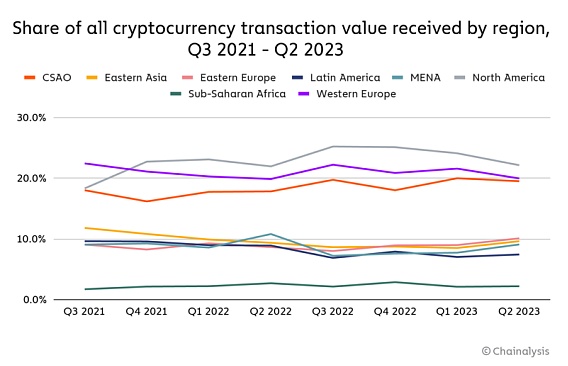
India is far ahead in terms of trading volume, receiving about $268.9 billion in cryptocurrency assets during the research period.
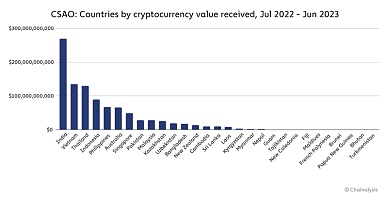
However, raw trading volume does not explain the whole picture. When we consider purchasing power and population to measure grassroots adoption, CSAO takes the lead. We see this in the Global Cryptocurrency Adoption Index, where six of the top ten countries are in this region: India (1), Vietnam (3), the Philippines (6), Indonesia (7), Pakistan (8), and Thailand (10). Additionally, DeFi played a more significant role in CSAO last year, accounting for an estimated 55.8% of the region’s trading volume from July 2022 to June 2023, compared to 35.2% in the previous year. The institutional adoption in the region also seems to have increased, with 68.8% of the total trading volume coming from transfers worth $1 million or more, compared to 57.6% in the previous period.

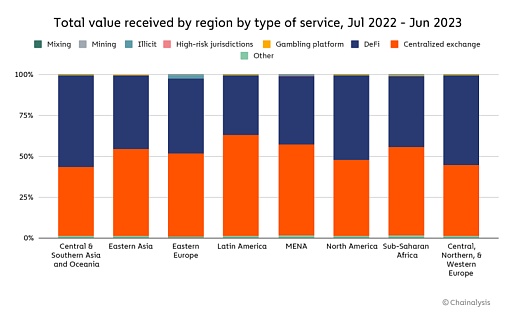
But it is important to note that CSAO is not a homogenous market when it comes to cryptocurrency adoption. The factors driving cryptocurrency adoption vary among different CSAO countries, leading to differences in the usage rates of different types of cryptocurrency services. We can see this in the following chart, which shows the breakdown of network traffic for different types of cryptocurrency platforms in CSAO countries with the highest adoption index.
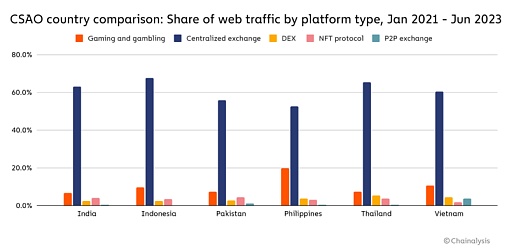
Among all these countries, centralized exchanges account for the majority of network traffic, which is also the case globally. However, we also see significant differences elsewhere. For example, a significant portion of the cryptocurrency-related network traffic in the Philippines goes to gaming and gambling platforms, accounting for 19.9%, followed closely by Vietnam at 10.8%. Meanwhile, countries like Pakistan and Vietnam have a higher share of activity in P2P exchanges, which are more commonly used in emerging markets or countries with stricter capital controls.
Next, we will explore the different driving factors for adoption in the CSAO countries of the Philippines and Pakistan, and examine how these differences lead to different usage patterns. Then, we will take a look at some recent trends in India, where the country is leading in grassroots cryptocurrency adoption.
The craze of Axie Infinity has kicked off the adoption of cryptocurrencies in the Philippines, but what will happen next?
For a long time, cryptocurrency enthusiasts have viewed the $217 billion video game industry as a sector where cryptocurrencies can have a positive impact, such as allowing players to earn, purchase, and sell in-game items. We have seen ambitious projects tackling this issue and achieving varying degrees of success. No country has embraced these projects quite like the Philippines, especially the game Axie Infinity, which has caught the attention of Filipinos. To learn more, we interviewed Donald Lim, a seasoned professional in the field of advertising and marketing in the Philippines. He works across multiple industries and has now entered the world of cryptocurrencies, serving as the first chairman of the Philippine Blockchain Commission and the main organizer of Philippine Blockchain Week.
“Lim says, ‘I believe Axie Infinity is the moment when cryptocurrencies truly landed in the Philippines. While the game is most popular among the younger generation, I see people from all walks of life playing it.’ You hop on a tricycle, and you’ll see the driver with their phone propped up on the windshield, playing Axie. There are so many stories like this. In fact, the Philippines accounts for the largest share of Axie Infinity’s network traffic, reaching 28.3%. On-chain data shows that the growth of cryptocurrency trading volume in the country aligns with the growth of Axie in the summer of 2021.”
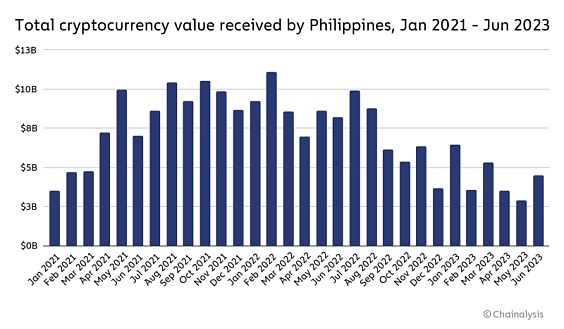
What makes the Philippines so receptive to “play-to-earn” games like Axie Infinity? Lim cites several reasons. First, the Philippines has a pool of tech-savvy young people who have already embraced fiat digital wallets like GCash. When Axie Infinity was launched and started gaining popularity, the world was in the midst of the COVID pandemic, and many people were stuck at home without jobs. Axie provided a means of entertainment and earning extra cash. It also offered a social channel. “Filipinos are accustomed to connecting through the internet and social media because, as an archipelago, we are naturally isolated from the outside world. We are also the world’s largest exporter of human capital, and Filipinos abroad want to connect with people back home,” Lim explains. He notes that social media usage in the Philippines is high, making it easier for the game to spread virally through influencer marketing and reach users.
Subsequently, the overall usage and token prices of Axie Infinity experienced a significant decline, and the economic situation of many Filipinos who abandoned the game did not improve much. However, the success of this game has laid the foundation for further cryptocurrency adoption, as many Filipinos who played the game now have wallets that can be used for other purposes.
Lim believes that the best way to turn the initial momentum into beneficial cryptocurrency applications is for regulatory agencies and large internet companies to step forward. “The adoption of cryptocurrencies cannot be just bottom-up. Governments need to establish rules, and the biggest companies need to incorporate cryptocurrencies into their products.” Positive developments have already emerged in these two aspects. The Philippine government has designated an economic zone in Batan, where cryptocurrency companies that open stores can enjoy tax benefits and operate in a regulatory sandbox designed to foster innovation. In the private sector, Philippine Airlines has recently launched a utility-driven NFT series that allows users to enjoy special treatment, while Philippine financial services company Cebuana Lhuillier has announced integration with the Stellar blockchain to provide faster and cheaper remittance services – which is crucial for countries like the Philippines that receive a large amount of funds from abroad.
Lim firmly believes that the Philippines has the ability to become a leader in the field of cryptocurrencies. “We can become the blockchain capital of Asia. Look at the developer talent, look at all the online groups dedicated to trading and NFTs – it’s just a matter of time.”
In Pakistan, demand is driving the application of cryptocurrencies (especially stablecoins)
Although Pakistan has a relatively low overall trading volume, it is one of the world leaders in the adoption of grassroots cryptocurrencies, not far behind the Philippines. However, the adoption patterns in the two countries are quite different. Social relationships and speculative behavior have led many Filipinos to enter the cryptocurrency field through “earning while playing” games, while the need for wealth preservation seems to be the reason why many Pakistanis are turning to cryptocurrencies in the face of high inflation and currency devaluation. We interviewed Zeeshan Ahmed, the regional manager for Pakistan at the well-known cryptocurrency exchange Rain, to learn more. Rain operates in multiple countries in the region, and because cryptocurrency trading is currently prohibited by Pakistani law, Rain currently does not conduct any commercial activities in the country, but it is striving to obtain regulatory approval one day.
When we asked Ahmed what is driving the adoption of cryptocurrencies in Pakistan, he provided some thought-provoking data. “Five years ago, Pakistan’s inflation rate was 10.6%. Now, the officially reported inflation rate is 29.4%, but in reality, it is much higher. The major surge has occurred in the past 16 months, where the value of the rupee has dropped from 1 US dollar to 178 Pakistani rupees in January 2022 to 320 Pakistani rupees in August.” Unfortunately, Pakistan’s severe economic situation means that savings are rapidly eroded. In addition, in the current environment, there are not many good investment options for ordinary people. “The stock market and securities exchanges have been struggling. Any earnings you get can be wiped out by inflation. Pakistani citizens are also prohibited from holding physical foreign currency – foreign currency must be deposited in banks. For many people, this makes cryptocurrencies, especially stablecoins, a necessity.” This is our only safe haven choice.
Equally important is that on-chain data does not provide a complete picture of countries like Pakistan adopting cryptocurrencies. The majority of transactions in the country, especially the acquisition of stablecoins, are conducted through informal peer-to-peer markets that are not easily identifiable on the blockchain. Therefore, it is difficult to determine exactly how many people hold or acquire cryptocurrencies at any given time. In addition, experts speculate that Pakistani businesses use stablecoins like USDT to import goods from abroad as a hedge against inflation and currency devaluation, but this is difficult to confirm.
Although Pakistan officially prohibits cryptocurrency trading, Ahmed believes that a clear regulatory framework would make the cryptocurrency market more effective for Pakistani citizens. While the official stance has not changed, Ahmed says he feels that some progress has been made in this regard recently. “Eight months ago, our regulatory authorities didn’t even want to talk about cryptocurrencies. But recently, in July of this year, we submitted a white paper to them on how to regulate cryptocurrencies, and they seem to be moving forward.” For example, future regulations may allow Pakistanis to transfer funds from bank accounts to exchanges, making it easier and more cost-effective for them to acquire the necessary digital assets and create conditions for further growth.
Despite challenges in tax laws, India remains a top cryptocurrency market
While other markets in the region are vibrant and can help us understand the unique drivers for cryptocurrency adoption, the largest CSAO cryptocurrency market to date is India. According to our Global Crypto Adoption Index, India has the highest grassroots adoption rate in the world, but even more impressively, India has become the world’s second-largest cryptocurrency market, surpassing several wealthier countries, based on estimated trading volume.

Cryptocurrency usage in India spans several different forms of activities, with India ranking in the top ten in different categories of cryptocurrency services.

Perhaps most impressively, despite the challenging regulatory and tax environment for the industry, India remains a top cryptocurrency market. Last year, regulatory authorities provided more clarity on many issues, such as formally ordering that its anti-money laundering rules apply to cryptocurrency transactions. However, India imposes much higher tax rates on cryptocurrency activities compared to most other countries, levying a 30% tax on profits—this is a specific tax rate for cryptocurrencies, higher than the tax rate for other investments such as stocks—and a 1% tax on all transactions, also known as a Tax Deducted at Source (TDS), which means cryptocurrency platforms must deduct the corresponding amount from users’ balances to complete transactions.
Recent reports further confirm that the uneven implementation of TDS may increase the competitive difficulty for local Indian exchanges. Although every exchange operating in India is required to collect TDS tax from Indian users, many international exchanges have not effectively done so, which may attract Indian users instead of being mainly concentrated in Indian exchanges. As we can see from the chart below, which shows evidence that after the implementation of TDS in July 2022, network traffic from India to international exchanges immediately surged.
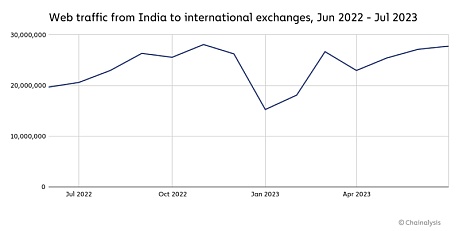
This trend highlights the importance of strict enforcement of local rules such as TDS by all exchanges operating in a specific country. Otherwise, it will create an environment for regulatory arbitrage and harm the local cryptocurrency industry.
However, despite these issues, they do not seem to suppress the huge demand for cryptocurrencies in India – as long as the demand exists, cryptocurrencies will have a place in the world’s second-largest country.
CSAO shows that cryptocurrencies can adapt to local conditions
No region has more reason than CSAO to believe that cryptocurrencies are the future trend. This is not only because the region has so many CSAO countries leading the way in grassroots applications. It is because these countries have extensive and unique economic needs, and different cryptocurrency platforms and assets have emerged to meet these needs. In the Philippines, many people want to speculate on new assets, earn extra cash, and establish digital connections with others. The “play games and earn cash” games have gained a foothold there. These games are entry points into the broader digital asset economy, and now thousands of Filipinos have cryptocurrency wallets that can be used for other purposes. In Pakistan, the economic situation is more severe – considering that Pakistan’s per capita purchasing power parity is $5680, while the Philippines’ per capita purchasing power parity is $9210, plus the currency depreciation we described – stablecoins are providing economic relief. If the Pakistani government enacts reasonable cryptocurrency regulations, its existing users will become the foundation for the prosperous development of the cryptocurrency market, just as we have seen in India. CSAO shows that cryptocurrencies can play a valuable role regardless of the national conditions of a country.
Like what you're reading? Subscribe to our top stories.
We will continue to update Gambling Chain; if you have any questions or suggestions, please contact us!